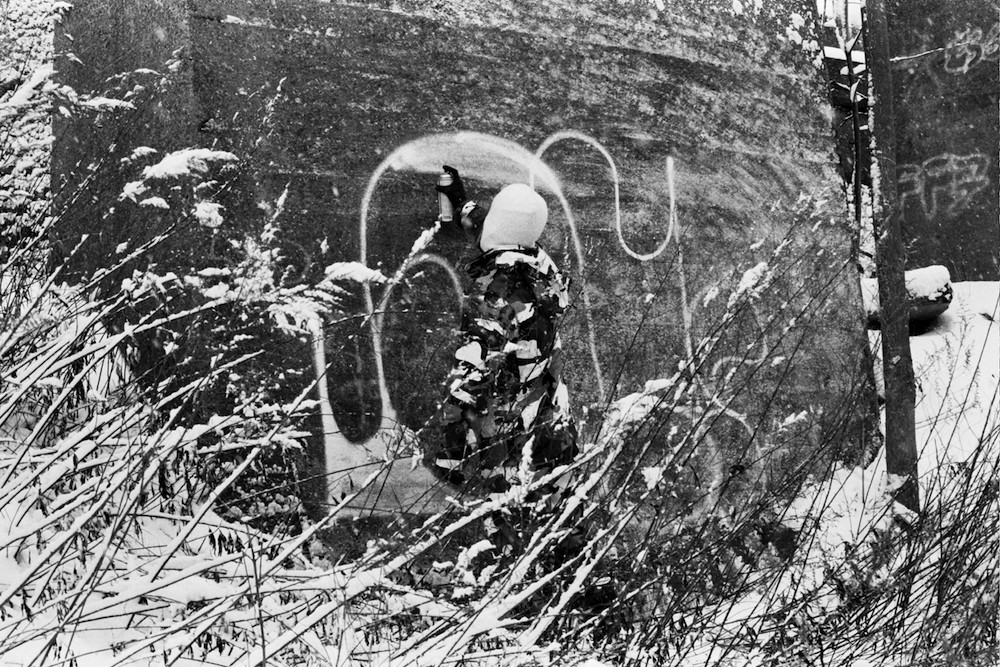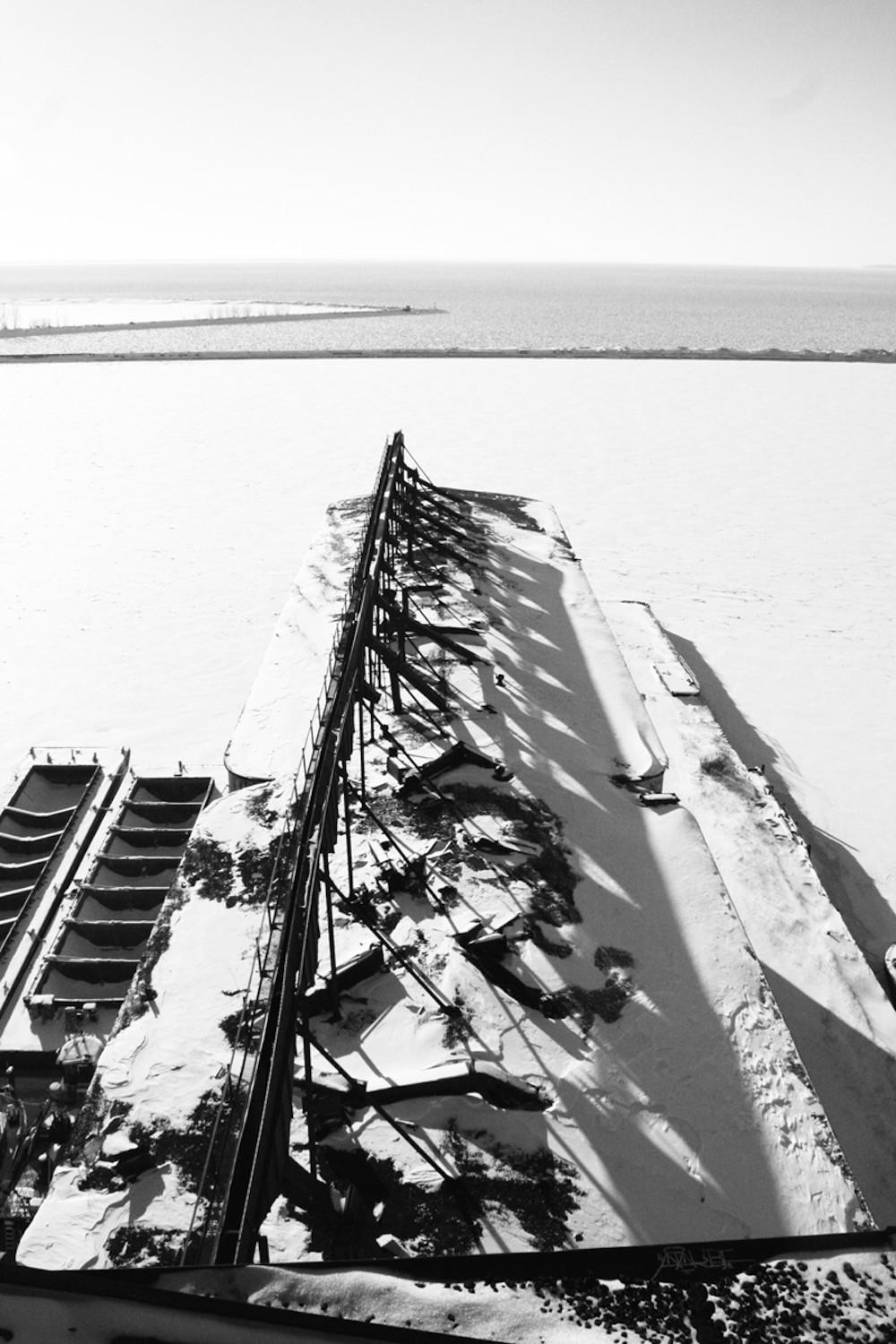

Writer’s Block is a semi-regular column that zeroes in on graffiti legends, street bombers, and modern-day vandals with a mixture of stories, off-the-cuff interviews, and never-before-seen pictures.
Graffiti writers tend to be great marketers. When your primary motivation for risking your safety and personal freedom is to become famous among your peers, as is the case with most writers, you tend to get pretty good at making sure that people pay attention to you. The best graffiti writers know their spots, their techniques, their style, their history, and—especially—their audience. They post their exploits on Instagram and other social media and pro-actively manage their reputation. It is extremely rare to meet a respected graffiti writer who largely eschews these tenets of self-promotion. ATAK BF from Buffalo, NY, is one of the few. His new limited-edition zine, Northern Boundary, allows a rare glimpse into the adverse conditions ATAK endures to produce his work and offers a counter-narrative to the popular conception of flashy, colorful graffiti.
Videos by VICE
In New York City and other places around the country, ATAK’s fleeting presence manifests in the form of his trademark grim-faced fill-ins that pop up overnight on virgin rooftop spots high above the street. Among graffiti writers and fans, ATAK is deeply respected for his unique style as well as his consistent output and the seriousness with which he approaches his graffiti. While his work is out everywhere on the streets, being able to flip through a zine of photos and documents curated by ATAK offers a rare opportunity to get a more personal (though still furtive) glimpse into the world of one of the graffiti underworld’s young kings.
He describes Northern Boundary as his “diary of isolation and desolation of Buffalo throughout winter.” Published in a limited edition of 300, Northern Boundary features 64 pages of stark, high-contrast, black-and-white imagery. Portraits of Buffalo’s forlorn shells of factories, warehouses, and grain elevators are paired with shots of painted walls embedded in snowy landscapes, graffiti action in sub-zero temperatures and white-out conditions, as well as the aftermath of powerful snowstorms—particularly archival footage from the infamous blizzard of 1977, a visual trope and historical touchstone in the zine and the lives of the city’s residents. Snow drifts that year reached highs of 30 to 40 feet, and 23 people lost their lives.
To ATAK, the extreme conditions in Buffalo during the winter only heighten his sense of isolation, which works to his advantage as an artist and graffiti writer. The city “becomes a different beast in the winter. For me it was always a period where I was able to accomplish a lot. So many people just sit inside and wait for spring to come. I can’t do that.”


The gritty, sequestered landscapes throughout Northern Boundary complement ATAK’s preference for working alone. Since starting out in the late 90s and choosing his word around the year 2000, he has always painted graffiti by himself, or with a handful of very close friends, because that’s how he discovered and honed his craft. “I grew up around a lot of industrial environments,” ATAK told me when we sat down for an interview in early 2016. He had been exploring and photographing abandoned buildings for a few years already when he became interested in graffiti. “Breaking into buildings [and] seeing words written repetitively” in inhospitable surroundings led him to try writing graffiti himself.
Eventually, he met fellow Buffalo natives and older, experienced graffiti writers LIONS and MERK JR who showed him the ropes and also introduced him to graffiti by some of the best writers around the country. “I visited New York City prior to meeting those guys, and had many eye-opening experiences. But you know, it’s overwhelming to you when you start, when you’re young,” he says. Once LIONS began to mentor him, “it started making sense and you realize, those dudes who are good, they didn’t really start good. It took years for that to happen.” LIONS, who had also put in time on the West Coast, “had photo albums of graffiti from San Francisco and New York, so I was exposed to TWIST [renowned, graffiti-turned-fine artist Barry McGee] pieces and more developed work than I had ever seen before.”
However, SETUP and REVS, two New York City graffiti legends known for their lone-wolf attitude and complete anonymity, would ultimately come to rank among his biggest influences. ATAK has gone on to develop his very own style, but it continues to be grounded in his upbringing among the bleak, post-industrial ruins of his hometown.

Most of the archival footage in the zine—such as an aerial of abandoned cars and a home laden with so many icicles that it looks like a gingerbread house covered in frosting, both from 1977—is appropriated from a little-known small-press book ATAK unearthed. He included these images in Northern Boundary, in part, because it allowed him to make another connection to Buffalo’s historic past. In our conversation, he names the former Bethlehem Steel plant in nearby Lackawanna, NY, as an example for a complex that once represented the greatness of American manufacturing. “It was basically a whole city in itself,” he recalls “and every year less and less of it exists. They demolish this part, get rid of that part, just because it’s mostly ‘obsolete’ structures left at this point. But to me, it’s part of American history”—not flag-waving, patriotic history, but the accumulation of tangible human accomplishment. The decline of Buffalo and other rust belt cities represents the eradication of an important stage of human progress. By exploring and documenting structures in extremely remote and hard-to-reach places, ATAK hopes to retain some of their significance. Buffalo, he admits, “is hellish in some ways, but it has a lot of character to it that people don’t see unless you spend a substantial amount of time there.”
He may celebrate Buffalo’s history, but the city does not return the favor when it comes to ATAK’s graffiti, and he has come to accept that. “I understand,” he relents. “[Graffiti] is a destructive thing; it’s money down the drain for people who are struggling. In Buffalo, it’s a depressed economy, it’s a depressed place, I totally get why people don’t like graffiti. The response to it that I feel is the most irrational and inappropriate is the egregious punishments laid out by the court system for those charged. As far as defending graffiti to someone that doesn’t like graffiti—I can’t really, there’s no point. Either you like it or you don’t.”


ATAK’s work is a product of Buffalo’s natural and man-made environments, which, in turn, provide a meaningful context. His graffiti style itself draws from the visual rigor of Buffalo’s ruins. “I’ve always been influenced by Brutalist and Art Deco architecture,” he recounts, pointing out the strict geometry of his pieces and grid-like linearity in many of the zine’s photos. “You can only be influenced by letters for so long before it starts to get repetitive.”
At a time when many established graffiti writers still reference the classic perfection of Subway-era graffiti with intricate-but-readable letters and a large variety of fill colors and other decorative elements (and very expertly so), ATAK’s pieces are composed of angular lines and use dark color schemes. “I never wanted to be a part of it,” he says, referring to hip-hop culture. “No disrespect to anyone who identifies with that, or is influenced by it in their efforts. Fundamentally, it is just very different from who I am.”
His aesthetic was also born from humble necessity. “I had very little natural ability starting out,” he admits. “I came to the early realization that I was never going to be able to do traditional-looking graffiti and I should try to do something that’s a little different.” He prefers to use industrial spraypaint, which limits his color palette, but ensures greater longevity. “I have a certain aesthetic I want to convey, and color isn’t really a part of it,” ATAK says. “People like to do the funky, friendly thing, and I never really wanted my graffiti to be perceived in that way. I’ve always kinda treated it as being more aggressive and more stern, stoic, you know—trying to have a punch to it.”
Most of the graffiti zines that are published in the US and around the world tend to focus on letters and paint on the wall and push the viewer to see the world of their creator through the prism of the colors he or she chooses to use. With Northern Boundary, ATAK took the uncommon step of letting his graffiti breathe and absorb strength from the spatial and historical context into which it was born.
Basically, he says, “it all goes back to exploring.”
Ray Mock is the founder of Carnage NYC and has been documenting graffiti in New York and around the world for ten years, publishing more than two dozen limited edition zines and books. Follow him on Instagram.



More
From VICE
-

Photo: Adrienne Bresnahan / Getty Images -

Photo: maiteali / Getty Images -

Photo: GK Hart/Vikki Hart / Getty Images

